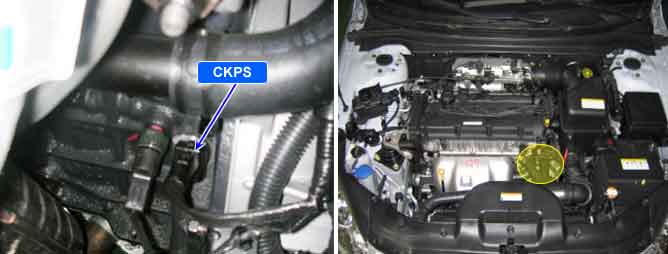

The Crankshaft Position Sensor (CKPS) is a hall effect type sensor that generates voltage using a sensor and a target wheel mounted on the crankshaft; there are 58 slots in the target wheel where one is longer than the others. When the slot in the wheel aligns with the sensor, the sensor voltage outputs low. When the metal (tooth) in the wheel aligns with the sensor, the sensor voltage outputs high. During one crankshaft rotation there are 58 rectangular signals and one longer signal. The ECM calculates engine RPM by using the sensor’s signal and controls the injection duration and the ignition timing. Using the signal differences caused by the longer slot, the ECM identifies which cylinder is at top dead center.
The ECM sets DTC P0335 when the number of crankshaft teeth during one revolution is incorrect or crankshaft signal is missing while camshaft signal is detected.
Item | Detecting Condition | Possible Cause | |
DTC Strategy | ● Check camshaft signal switching | ● Open or short in signal, ground or power supply circuit ● Contact resistance in connectors ● Damage to the connecting flange/flywheel ● Misadjust crankshaft and camshaft pulley position ● Faulty CKP sensor | |
Enable Conditions | ● 10V< Battery voltage < 16V ● No relevant failure | ||
Threshold Value | Case1) | ● No crankshaft teeth during 4 camshaft signal transition | |
Case2) | ● Crankshaft Teeth detected but synchronization not successful | ||
Case3) | ● No signal or Numder of Crankshaft Teeth within one revolution is abnormal | ||
Diagnosis Time | Case1) | ● 2 revolutions | |
Case2) | ● 2 revolutions | ||
Case3) | ● 2.5 revolutions | ||
Mil On Condition | ● 2 Driving Cycles | ||

